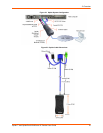
Spider™ and SpiderDuo® KVM-over-IP Device User Guide 16
2: Overview
Lantronix Spider and SpiderDuo distributed KVM-over-IP devices are designed to remotely and
securely provide monitoring and control of one target computer system by one or more remote
users. The remote user (client) accesses the Spider or SpiderDuo device over a local or wide area
network connection using a standard web browser.
Spider and/or SpiderDuo device is an evolution of the traditional remote KVM device into a
compact package. It is light enough to be cable-supported from the back of a server and takes up
no rack space.
Both devices differ from other KVM-over-IP devices in several ways. Unlike rack mounted KVM-
over-IP devices, the allocation of one Spider device per computer allows add-as-you-grow
scalability and guarantees non-blocked BIOS-level access to mission-critical servers regardless of
the number of remote users or servers that need access.
This chapter contains the following sections:
Spider Overview
SpiderDuo Overview
Product Information Label
Note: The terms Remote Console and KVM Console are synonymous and used
interchangeably throughout the User Guide.
Spider Overview
The Spider device features, functionality, system configuration and cables, and technical
specifications are described in the following sections:
Features
Functionality
System Configuration and Cables
Technical Specifications
Features
The Spider device is unique in that it is low-enough in power consumption to be powered from the
attached server. The color-coded cable plugs for the keyboard, mouse, USB port and video are
designed to plug directly into the target server. An optional external AC/DC power supply is
available.
It uses Lantronix SwitchPort+ technology to incorporate two hardware-switched Ethernet ports,
one for the primary network connection and the second for daisy-chaining Spider devices, or
aggregating other Ethernet connections (for example, a dedicated management LAN port on the
controlled system). This provides a cost-effective solution in environments in which numerous
cable drops and distance limitations are challenging when adding servers.
The Spider device comes in the following four models:
One model with both PS/2 and USB keyboard and mouse interfaces (software selectable)
One model for USB-only systems


















